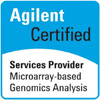home
 services
services  platforms
platforms  agilent: ChIP-on-Chip
agilent: ChIP-on-Chip
|
ChIP-on-Chip hybridisations allow researchers to identify regulatory regions that may be affected by a particular protein. It provides insight into the mechanisms of methylation, histone modification, and DNA replication, modification and repair. |
|
Upon acquiring Computational Biology Corporation, a biotech pioneer in ChIP-on-chip, in January 2005, Agilent
now has exclusive access to patent and intellectual property for ChIP-on-chip analysis.
There are different methodologies to consider when planning a ChIP-on-Chip experiment. Many researchers employ
the design of an “enriched” IP sample compared against a whole chromosome input sample. Others compare the IP
sample and a “no-antibody” control. Either design can be used on the Agilent platform.
Several amplification methods available. Agilent's current
ChIP protocol involves a ligand mediated PCR (LM-PCR) method which requires shorter DNA fragments than a
random primed method. It is also possible to use a whole genome amplification kit (such as is available from
Sigma). The methods involved in the immunoprecipitation step and the amplification step do require a fair
amount of optimization in order to generate sufficient sample while maintaining a difference between the
channels and generate PCR products that are of sufficient length to hybridise in a discriminating manner.
The individual methods all have their strengths and weaknesses but any can be used if optimised correctly.
The catalogue ChIP-on-chip arrays from Agilent are primarily 244K arrays or 2 design 244K arrays (1 array
takes up 2 slides).
Service includes:
- Labelling of two DNA samples per array with cyanine-3 and cyanine-5
- Hybridisation/washing/scanning of arrays
- Spot quantification (Agilent Feature Extraction)
- Feature Extraction output files sent to customer (FTP)
Sample Requirement:
High quality purified amplified DNA (following the immunoprecipitation) is required for labelling. A total of 2 ug is required per 244K slide. This means that for the 2-design arrays, a total of 4 ug is necessary. The DNA needs to be at a concentration of 100 ng/ul.
Pricing: Download
![]()
Please note that this pricing is for academic groups. Commercial customers should
contact us for a quote.
Contact: Agilent Service at
Custom designs are also available.
ChIP-on-Chip is also available on the UHNMAC array platforms.


